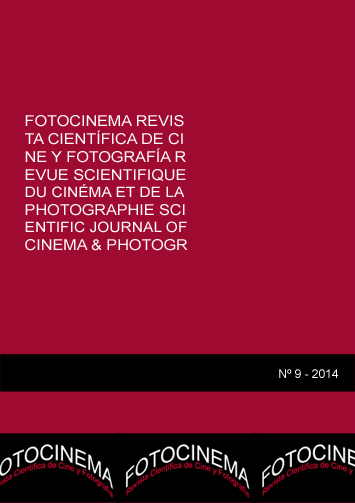El Two-Color Kodachrome y su inserción en The Llight in the Dark (Clarence Brown, 1922): primera y única exhibición pública del proceso experimental de color en un largometraje comercial
DOI:
https://doi.org/10.24310/Fotocinema.2014.v0i9.5963Abstract
El Two-Color Kodachrome fue un proceso experimental de color de la Eastman Kodak Company, inventado por John G. Capstaff (en 1913 para fotografía fija y desde finales de 1914 adaptado al celuloide), y el primer método fotoquímico de color sustractivo que se aplicó a la cinematografía. Se introdujo en un único largometraje comercial, que supuso a la vez la primera exhibición pública del sistema: The Light in the Dark (Clarence Brown, 1922). Pese a las buenas críticas, después quedó restringido a la experimentación dentro de la compañía y a cortometrajes. Este artículo examina el sistema de color en sí mismo, así como el modo en que se insertó en la película, de la que no han sobrevivido ni su negativo original ni la única copia que existió de ella en Kodachrome. Esto último se realiza a través de la confrontación de material de archivo inédito y de testimonios de pruebas en Kodachrome simultáneas al rodaje del film. Conocemos así cómo fueron las imágenes en color de la película y el estado de desarrollo exacto del sistema en 1922. Se examina también la evolución posterior del Kodachrome y su ausencia de éxito para su adopción por parte de los estudios de Hollywood.
Abstract:
Two-Color Kodachrome was a color experimental process from the Eastman Kodak Company, invented by John G. Capstaff (in 1913 for still photography and since the end of 1914 adapted to motion pictures), and it was the first photochemical method in a subtractive color system applied to cinematography. It was introduced in an only one commercial feature, which meant at the same time the first public exhibition of the system: The Light in the Dark (Clarence Brown, 1922). Despite obtaining good reviews, later the system was restricted to the experimentation within the company and shorts. This article examines the color system by itself, as well as the way in which the color was inserted into the film, of which neither the original negative nor the only print of it that included the Kodachrome have survived. Principio del formulario
The latter is carried out through the confrontation of unpublished archival material and examples of existing tests that were filmed in Kodachrome simultaneously to the shooting of the picture. This way we can know how the color images of the film were, as well as the exact state of development on the system in 1922. It is also examined the subsequent evolution of Kodachrome and its lack of success in being used by the Hollywood studios.
Palabras clave: Two-Color Kodachrome; Kodak; John G. Capstaff; George Eastman; Jules Brulatour; The Light in the Dark (Clarence Brown, 1922).
Keywords: Two-Color Kodachrome; Kodak; John G. Capstaff; George Eastman; Jules Brulatour; The Light in the Dark (Clarence Brown, 1922).Downloads
Metrics
Publication Facts
Reviewer profiles N/A
Author statements
Indexed in
-
—
- Academic society
- N/A
- Publisher
- Universidad de Málaga
Downloads
Published
How to Cite
Issue
Section
License
All contents published in Fotocinema Revista científica de cine y fotografía are protected under the Creative Commons Attribution-NonCommercial-ShareAlike 4.0 International (CC BY-NC-SA 4.0) license. All about this license is available in the following link: <http://creativecommons.org/licenses/by-nc-sa/4.0>
Users can copy, use, redistribute, share and exhibit publicly as long as:
- The original source and authorship of the material are cited (Journal, Publisher and URL of the work).
- It is not used for comercial purposes.
- The existence of the license and its especifications are mentioned.
There are two sets of authors’ rights: moral and property rights. Moral rights are perpetual prerogatives, unrenounceable, not-transferable, unalienable, imprescriptible and inembargable. According to authors’ rights legislation, Fotocinema. Revista científica de cine y fotografía recognizes and respects authors moral rights, as well as the ownership of property rights, which will be transferred to University of Malaga in open access. The property rights are referred to the benefits that are gained by the use or the dissemination of works. Fotocinema. Revista científica de cine y fotografía is published in an open access form and it is exclusively licenced by any means for doing or authorising distribution, dissemination, reproduction, , adaptation, translation or arrangement of works.
Authors are responsable for obtaining the necessary permission to use copyrighted images.














13.png)



